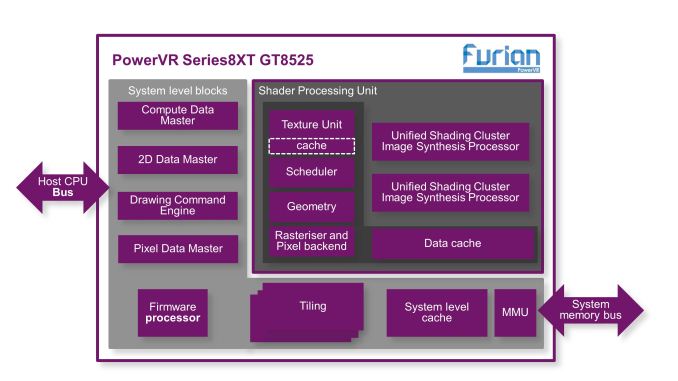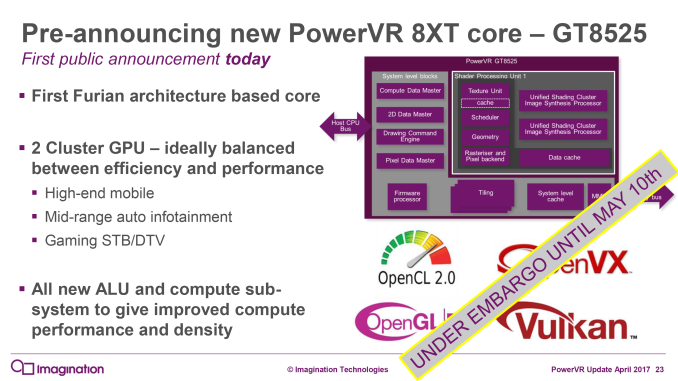Imagination Announces PowerVR Series 8XT GT8525: Their First Furian GPU Design
by Ryan Smith on May 10, 2017 11:00 AM EST- Posted in
- GPUs
- Imagination Technologies
- Furian
- PowerVR Series8XT

Back in March of this year, Imagination announced their next-generation GPU architecture: Furian. Their first new architecture since Rogue in 2010, Furian iterates off of what Imagination has learned in the intervening years to further improve their architecture’s performance, power efficiency, and die area efficiency. At the time the company only announced the architecture and not any GPU designs based off of it, but today they are taking the wraps off of the first Furian design: the PowerVR Series 8XT GT8525.
With their first design, Imagination is taking the pragmatic route – or as they like to put it, the balanced route. Outside of Apple, most of Imagination’s customers have been licensing two cluster designs from the high-performance PowerVR families (6XT, 7XT, 7XT+), so this is where Imagination is starting for Furian and the new Series 8XT.
By and large then, the GT8525 is exactly what you’d expect for a 2 cluster design based on Imagination’s earlier disclosure. 2 clusters are by design intended to fit inside of one of Imagination’s shader processing units, giving the design a single such unit.
The significance of this choice, besides being the smallest possible full implementation of Furian (before you start removing pieces from the design and get fractional) is that one of the areas Imagination focused on was improving the pixel and texel throughput at this level. As a result, a 2 cluster Furian design offers 8 pixels and 8 bilinear filtered texels per clock whereas a 2 cluster Rogue (e.g. GT7200) offered 4 of each. So even though it’s still only 2 clusters, even after you ignore the architectural improvements, there’s actually a lot more hardware working in a 2 cluster design.
| PowerVR GPU Comparison | ||||
| GT8525 | GT7200 Plus | |||
| Clusters | 2 | 2 | ||
| FP32 FLOPS/Clock | 192 (128 MAD + 64 MUL) |
128 (MAD) |
||
| FP16 Ratio | 2:1 (Vec2) | 2:1 (Vec2) | ||
| Pixels/Clock (ROPs) | 8 | 4 | ||
| Texels/Clock | 8 | 4 | ||
| APIs | OpenGL ES 3.2 + Vulkan | OpenGL ES 3.2 + Vulkan | ||
| OpenCL | 2.x | 2.0 | ||
| Architecture | Furian | Rogue | ||
By the numbers, Imagination is touting some rather significant performance improvements for GT8525 over its predecessor, GT7200. 50% faster performance in GFXBench Manhattan, 80% faster in GFXBench T-Rex, 50% more (on paper) FLOPS, etc. All of this would be at equal clockspeeds, though the company isn’t talking about power consumption or die size right now, so it’s hard to get a feel for where energy and area efficiency of the new design stands.
With this 2 cluster design, Imagination is going to be pursuing a mix of markets, though ultimately it’s up to SoC venders to build suitable SoCs. This includes smartphones, of course, but also mobile VR, which is a growing market that has a lot of potential for GPU vendors like Imagination given the performance requirements. The company is also pitching the new GPU design for the automotive market, where along with infotainment duties, a 2 cluster design should be powerful enough for some light ADAS work (presumably just doing computer vision on one or two camera streams).
To that end, the company has also announced that the design has already been delivered to their (unnamed) lead customer. Traditionally this would be Apple, but of course we know that Apple will be rolling out their own GPU architecture starting in the next 1-2 years. Instead this could be the likes of MediaTek or another at-large SoC vendor. In any case it’s possible we’ll see the devices using this design in 2018, though it’s ultimately up to the SoC vendor and device vendor on how quickly they want to move.
More broadly speaking, Furian and the GT8525 will be a critical product for Imagination. As the company announced last week, they are doubling-down on their GPU products and selling off everything else. Without Apple, they need to capture a larger part of the GPU market share in smartphones and other embedded devices. Consequently, starting with a 2 cluster design is the smart choice here, as 2 cluster designs are going to have the highest volume.












23 Comments
View All Comments
melgross - Wednesday, May 10, 2017 - link
We really don't know anything about whether h]this customer is Apple or not. In fact, there is a strong possibility that this will be the last Imagination IP Apple uses, not the previous one. If it's already rolling off, it's possible we'll see this. That one to two years schedule Apple gave them is still a ways off.For all we know, Apple is using some of in this years SoC. I wouldn't be surprised.
Yojimbo - Wednesday, May 10, 2017 - link
Judging by Imagination's history it will be over a year from now, perhaps 2. From that standpoint alone it is possible Apple will use it. However, wouldn't it be safe to assume that if this customer is using 2 clusters, it's probably not Apple? Imagination has Rogue-based GPUs (Series 8XE and Series 8XE Plus) newer than what Apple used in the iPhone 7. My guess is that it is these GPUs that Apple has plans to use over the next one to two years.Yojimbo - Wednesday, May 10, 2017 - link
The first sentence was meant to say "Judging by Imagination's history it will be over a year from now until this Furion-based GPU is released in a product."SydneyBlue120d - Thursday, May 11, 2017 - link
I bet time to market will be greatly improved with the new focus on GPU only...Yojimbo - Thursday, May 11, 2017 - link
I doubt it. I think it's not that they are taking a long time to get to market, it's that they announce their upcoming products an extremely long time in advance. Plus, I have read reports that Apple is hiring away some of their GPU engineers.Alexvrb - Thursday, May 11, 2017 - link
That's because what they're making is the design. They aren't producing Apple's chips, for example. They give them access to the latest design, Apple integrates it into their SoC, and has it fabbed. Obviously that's a gross simplification, but any SoC designer that uses their design will take a while to get it into products. With that being said, it may be possible for them to work more closely with these vendors to get product out a little bit faster.vladx - Wednesday, May 10, 2017 - link
Yeah it's most likely either MediaTek or Xiaomi.mczak - Wednesday, May 10, 2017 - link
Albeit a 2 cluster design doesn't exactly sound like "high-end mobile" to me in 2018 - midrange yes, highend no. Even the 2017 MediaTek Helio X30 is using a four cluster Rogue (and although it has rather high clocks, the gpu is unlikely to keep up with other current high-end chips), so despite clusters being faster, this would be a step back.vladx - Wednesday, May 10, 2017 - link
Average Joes don't look out for the cluster size of the GPU part, but for the number of cores on the CPU side. That, and this is only the first Furian design, others with 4 or more will surely follow soon enough.Alexvrb - Wednesday, May 10, 2017 - link
I do take issue with them saying high-end mobile, because that's where the 2-cluster configuration will be when it ships. Furian should offer improved performance for the low to mid-range, while keeping die area down. With that being said, with higher clocks a 2-cluster Furian should match the series 7 quad cluster in the X30. Either way, I know they're going for volume first but I am most interested in the 4+ cluster Furians.If they offer a variant that is DX12 compatible, I'd like a 6+ cluster model in a high-end ARM SoC running Windows on ARM on a tablet. Like a non-Pro Surface class device.